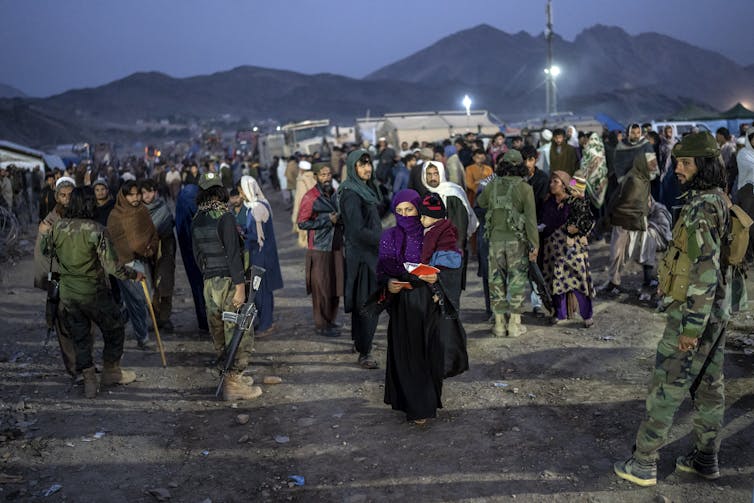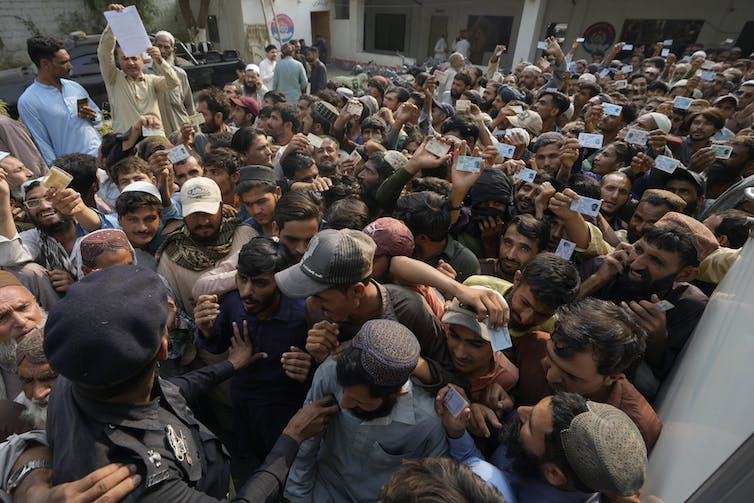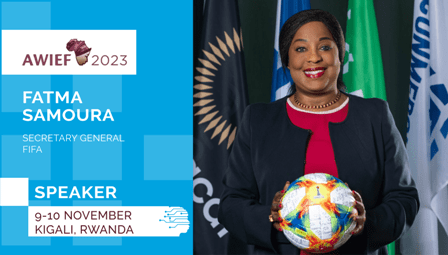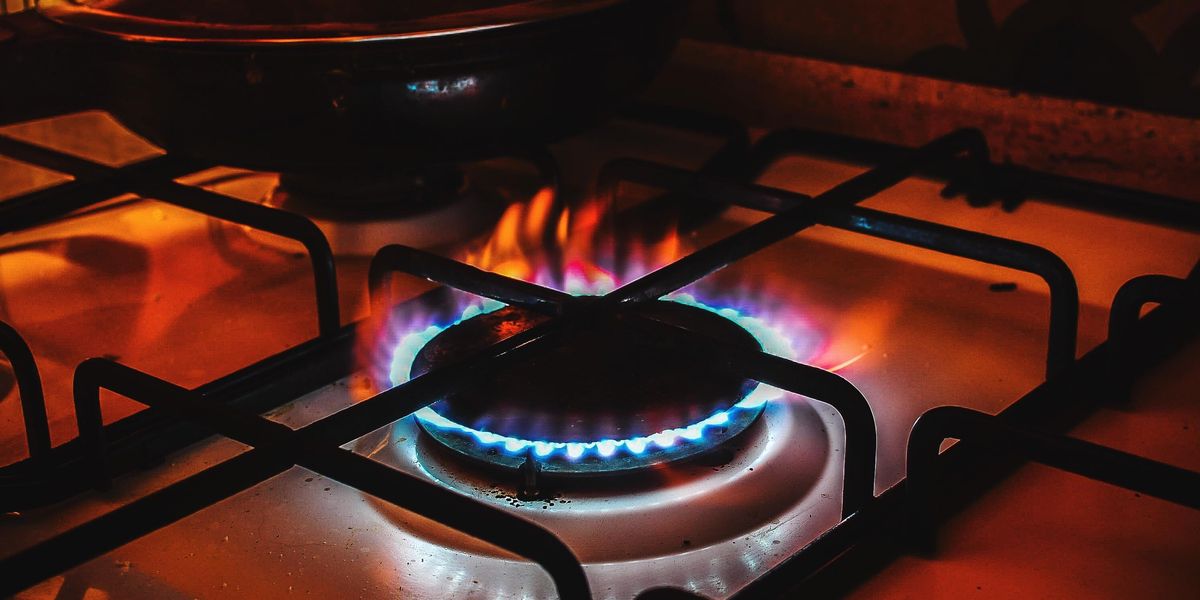On November 1, Pakistan began a nationwide operation to deport over 1.7 million Afghans it says are living in the country illegally. There are now an estimated 10,000 people returning to Afghanistan each day.
Pakistan has indicated the deportations are designed to reduce cross-border incursions from Taliban fighters based in Afghanistan. But it is more likely the interim military government is succumbing to populist politics around inflation, housing shortages and cost of living pressures in the country.
There were already over a million Afghans living in Pakistan before the Taliban came back into power in Afghanistan in August 2021. But the UN High Commissioner for Refugees (UNHCR) has been unable to process all of the estimated 600,000 to 800,000 Afghans who have fled to Pakistan since then. It is estimated only about a third of Afghan refugees in Pakistan are registered with the refugee agency.
The level of documentation that Afghans in Pakistan have varies extensively. Some entered the country without visas and passports. Some entered on visas and have been waiting indefinitely for renewal, others are on expired visas.
The UNHCR has subcontracted much of the registration of refugees to other organisations in Pakistan. Often, payment to a local broker is the only way refugees are able to get an appointment. This is entirely unreasonable when countries like Australia require UNHCR registration of refugees to facilitate priority processing.
Fareed Khan/AP
Many refugees experience lengthy waiting periods to be registered, formally recognised as refugees and then issued an ID card, let alone referred for onward resettlement. Shelter, food and medical assistance are not even considered.
Refugee identity documents are not even enough to protect people from deportation. There have been reports of police detaining and threatening people with valid Pakistani visas. Activists told me of incidents in which police have torn up valid visas and Afghan passports.
Many Afghans have applied for resettlement in countries that were members of the NATO-led force that maintained security in Afghanistan, such as the US, Canada, Australia and countries in the European Union. But as the world has turned its eye to other conflicts, those countries have fallen drastically short of their promises to Afghan refugees. It is estimated only 200,000 Afghans have been resettled globally since August 2021.
‘I feel suffocated’: Afghans are increasingly hopeless, but there’s still a chance to preserve some rights
A trickle of visas approved for Afghans
Human Rights Watch has also highlighted the unreasonably slow processing times for Afghan refugees in resettlement countries, such as the US, UK, Germany, Australia and other EU countries. This is particularly true for women and girls, the organisation says:
Afghan women and girls have often faced greater barriers to obtaining asylum, as destination countries have often prioritised assisting Afghans – overwhelmingly men – who contributed to their military efforts.
Since the Taliban returned to power, only 12,200 Afghan applicants have received a humanitarian visa to enter Australia. During the 2022 federal election campaign, Labor promised to increase the total refugee and humanitarian intake to 27,000 people annually. But this hasn’t happened.
Australia has promised just 26,500 humanitarian and 5,000 family places for Afghans from 2021-26.
Yet, there are more than 147,000 Afghan applicants still in the queue waiting to be processed from the 189,000 applications received since August 2021. And earlier this year, the Department of Home Affairs quietly removed human rights defenders from its list of groups to receive priority visa processing from Afghanistan.
A dire situation for women and girls
Former US President George W. Bush said in the early 2000s that the US went to Afghanistan to liberate the country’s women, but those women have been forgotten now.
Today, Afghanistan remains in one of the world’s most dire humanitarian crises.
The United Nations has described a system of gender apartheid under Taliban rule, in which women are prevented from participating in any public life, education or economic activity outside the home.
Infant and maternal mortality rates have skyrocketed because women are not allowed to travel to seek medical attention, female doctors are not allowed to work and male doctors are not allowed to treat female patients.
Leaders of NGOs that work on women’s education and other women’s rights continue to be disappeared. Women who are brave enough to protest on the street are beaten. Journalists are routinely detained for covering such issues.

Ebrahim Noroozi/AP
Last year, the UN Women’s Peace and Humanitarian Fund launched a new program dedicated to supporting women’s human rights defenders around the world. However, I’ve been told this program is now facing a US$14 million (A$22 million) funding shortfall.
This fund provides small grants to a number of Afghan women’s human rights defenders to fund their ongoing advocacy work and relocate them or help them flee when their lives are in danger. Often, these women need this money to pay exorbitant prices for visa extensions to stay in Pakistan, or for exit permits to leave the country if they are given a resettlement place elsewhere.
If countries like Australia and the US help make up this shortfall, more women will have access to these grants and be able to escape extreme security risks.
What now for Afghans living in limbo?
Western countries must keep their promises to process refugee visa applications for Afghans in a timely fashion.
Australia refuses to grant refugee visas to people currently in Afghanistan. Yet, the government is still taking years to process the claims of incredibly high risk individuals outside the country who meet several priority processing criteria. Those people fled to countries like Pakistan and Iran and are now being deported because the process has taken so long.
As the Taliban returns, 20 years of progress for women looks set to disappear overnight
Similarly, Afghans who are eligible for special immigrant visas to the US can also wait for years. Even if they get an appointment with the US embassy in Islamabad, there is no guarantee of a timeline when they will be sent to the US.
These timelines have to change. Globally, poorer countries shoulder the burden as the hosts of the overwhelming majority of refugees. Pakistan is now deporting Afghans. Iran, host to more than three million Afghan refugees, will likely follow soon.




